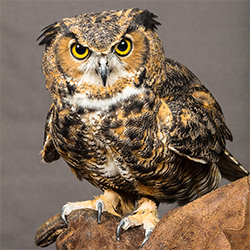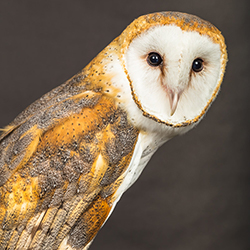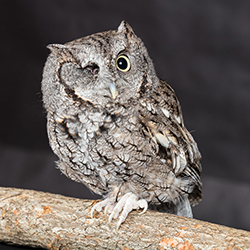The International Festival of Owls is an annual event that began in 2003 with the hatching day of Alice, a great horned owl from Antigo, Wisconsin. The first event was meant to encourage people to get out of the house at the end of winter, and learn a little something about owls. Now each year on the anniversary of her hatching, people travel from all over the world to join in celebrations and learn about our nocturnal feathered friends.
Your Akron Zoo has its own parliament of education owls who are more than happy to meet people from across Northeast Ohio and teach them about owls with our ZooMobile. In fact, we have three owl ambassadors: Albus, Lorain, and Hoot. Each of our owls has a unique story and a lot to share!
Hoot
 Hoot is our great horned owl. We estimate that he was born in 2004 in his natural habitat, but after a wing injury, he was rescued and taken to a rehabber who deemed him non-releasable. He has been an animal ambassador at the Akron Zoo since 2011.
Hoot is our great horned owl. We estimate that he was born in 2004 in his natural habitat, but after a wing injury, he was rescued and taken to a rehabber who deemed him non-releasable. He has been an animal ambassador at the Akron Zoo since 2011.
Like most owls, great horned owls can rotate their heads three-quarters of the way around, approximately 270 degrees. They cannot move their eyes from side to side but have extremely flexible necks and can move their heads quickly, which makes it look like they are turning their head all the way around.
Owls can see fine during the day, but see exceptionally well at night. They have a third, opaque eye membrane, called the nictitating membrane, which helps to clean the eye of material and protect the eye from the brightness of day or foreign objects at night. Owls utilize their facial discs to funnel sounds from all around, giving them the best hearing of all birds. Most of their brain is devoted to sorting out auditory signals. The ears are located on the sides of their heads and are hidden by feathers.
Great horned owls occupy the most extensive range of any owl. They are a top predator, and they keep populations of many smaller creatures in check via hunting. Great horned owls are on the top of the food chain and only risk predation by humans or other large owls who are desperate for food.
Though this species has a stable population, they are still protected by state and federal governments in order to ensure their survival.
Albus
 Albus, our barn owl, was born in May 2010. He was partially reared by his parents and partially reared by humans, which means that he has imprinted on humans and is comfortable as an animal ambassador.
Albus, our barn owl, was born in May 2010. He was partially reared by his parents and partially reared by humans, which means that he has imprinted on humans and is comfortable as an animal ambassador.
In their natural habitat, barn owls only live to be one or two years old. However, in human care, these owls have been known to live up to 15 years, putting good old Albus in the prime of his life!
Though his name may remind you of a beloved Harry Potter character, Albus is actually named after the Latin name of his species, alba. There are 9 species of barn owls, and 36 subspecies of Tyto alba worldwide. Barn owls are classified separately from “true owls” because of several unique anatomical differences, including a white, heart-shaped facial disc; a serration along the inner edge of the central talon of each foot; long, slender legs; and very dark eyes.
Like all barn owls, Albus does not hoot. Instead, the most common sounds of barn owls are high-pitched screams, clacking and hissing sounds. Despite their noisy chatter, barn owls still have the most sensitive hearing out of any animal that has been tested. They are also able to fly almost completely silently, which is a great advantage in hunting.
Barn owls are considered endangered in Ohio, but IUCN designated them “Least Concern” worldwide. Nest boxes for barn owls are being set up to help give them more housing in areas where they experience habitat loss. These owls do not pose a threat to humans, although they will defend their territory and young against intruders.
Lorain
 Lorain is an Eastern screech owl, so named because she was hit by a truck when flying across a road in Lorain, OH. The individual driving recognized that he had hit an owl and went back to find her and take her to local rehabber. Because of the collision, Lorain sustained several injuries to her face that caused her to lose an eye and her beak to scissor, which left her unfit to be released. However, she is now happy to be in human care and a part of our animal ambassador team!
Lorain is an Eastern screech owl, so named because she was hit by a truck when flying across a road in Lorain, OH. The individual driving recognized that he had hit an owl and went back to find her and take her to local rehabber. Because of the collision, Lorain sustained several injuries to her face that caused her to lose an eye and her beak to scissor, which left her unfit to be released. However, she is now happy to be in human care and a part of our animal ambassador team!
Eastern screech owls are the smallest species of owl in North America. These owls are mostly nocturnal and do most of their hunting at dawn and dusk, but will occasionally hunt during the day. They also like to bathe themselves regularly, which occasionally results in them being found dead in rain barrels.
The plumage of the Eastern screech owl is colored in a way that allows them to hide against trees and look like bark. There is an old saying that their eerie call is soon followed by death and disaster. Some other common names are Spirit Owls, Whickering Owls, Demon and Death Owls.
ALL owls are protected by state and federal regulations, and it is illegal to capture or kill an owl. It is also illegal to possess an owl, living or dead, unless you receive special permission from the proper authorities. Eastern screech owls are not considered endangered, but climate change has played a role in changing their population. A researcher who has been studying Eastern screech owls for 40 years noticed that there has been an increase in rufus colored owls. This coloring is genetically determined. The rufus-phase Eastern screech owl has feathers that are porous and adequately dissipate body heat, suited for hot and humid climates. In low light areas, rufus also is harder to see, decreasing chances a predator will find them. Gray screech owls, whose numbers have not increased, are better equipped to protect against colder weather.
So, if you love owls, happy International Owl Festival weekend! Be sure to visit our unique owls, as well as the other species who call the Akron Zoo home! You’ve never been this close!
By Erica Rymer, Events and Marketing Specialist. Published March 2, 2019.
